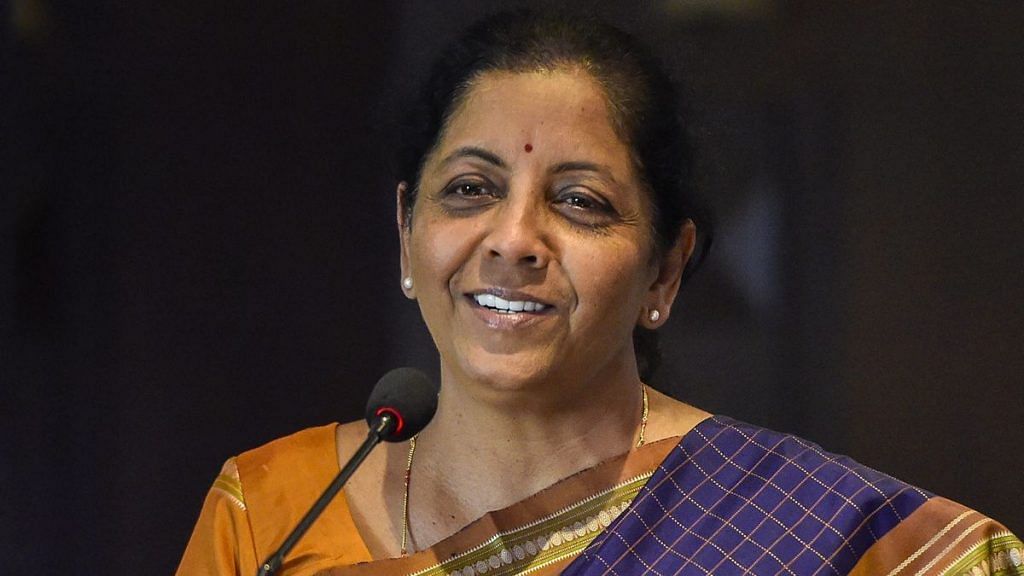In the eyes of India’s male politicians, any political battle is already half-won if the opponent is a woman. The possible lines of attacks have long been drawn and one has to simply pick and choose — from women’s appearance to their jewellery to, oftentimes, just their gender. As Parliament opened Monday to begin the monsoon session, Finance Minister Nirmala Sitharaman became the latest target of Indian men’s ingrained misogyny when a member attacked her appearance while trying to take a potshot at the state of India’s economy.
Prime Minister Narendra Modi can grow his beard and draw accolades from across the political divide, but Nirmala Sitharaman must maintain her appearance at all times — because she is more a woman than a minister. Male politicians have to shield criticism for their statements, their actions — but someone like Sitharaman or Smriti Irani are left to defend their ‘domestic’ roles of ‘tai’ or ‘aunty’ because these are the positions India’s patriarchal society has designated for them. Women can break the ‘glass ceiling’, become defence minister or finance minister — but they must only negotiate within the boundaries of the meek ’Bharatiya naari’ demeanour. Any sign of assertiveness will be seen as crossing the ‘Lakshman rekha’.
Also read: Sit girl, in the corner: Across the world, the many proverbs that keep sexism alive
Economy is an issue, but…
Indian economy has faced a tough time in the past too. Whether it’s in 1991, when the government had to pledge gold to rescue the economy, or the double-digit inflation for several years from 2011, India has often found itself battling a tough economic scenario. But this toxicity and the venom directed at the country’s first full-time woman finance minister is certainly novel.
It must be obvious to anyone who cares to see that the kind of attacks Sitharaman faces are largely because of her gender. It is no different than Congress president Sonia Gandhi being routinely attacked on social media as a ‘bar dancer’.
But behind this gender-specific attack is also Sitharaman’s assertiveness, which makes men uncomfortable. This is why she is often asked to “smile more”.
Sitharaman has an MA and MPhil but none of these qualifications matters to her critics who only see a ‘tai’ in her — an identity that is all too easy to target because of how the Indian society normalises women as ‘weak’. Many people in India Inc, in the financial circles, in their WhatsApp forwards refer to Sitharaman only as ‘tai’.
Then there are the continuous discussions about Sitharaman’s ‘anger’. And yet, no one sees Rahul Gandhi and Arvind Kejriwal’s tirades as emotional ‘outbursts’.
Also read: Locker room boys to IT cell men: India’s rape culture grows without shame or consequences
Not the first time
Monday’s incident against Sitharaman in Parliament is not the first time that a woman politician in India has faced a sexist attack — and it certainly won’t be the last.
In January 2019, Congress leader Rahul Gandhi took a potshot at Sitharaman, saying that PM Modi “got a woman to defend him” on the Rafale deal debate in Parliament.
“The watchman with a 56-inch chest ran away and told a woman, Sitharaman ji, to defend me,” Gandhi had said.
Men have repeatedly singled Sitharaman out for India’s economic slump — primarily using the ‘Nirmala tai’ nomenclature, as if to suggest her gender has had a role to play. But you won’t find anyone blaming the real CEO of the country — PM Modi — by seeking to draw a relation between his long beard and the long slide in India’s GDP.
The continued signalling towards her gender suggests that for Sitharaman, the situation is like this — step down from the post or face sexist remarks.
Before that, in 2014, Modi had asked West Bengal Chief Minister Mamata Banerjee to control her “anger” because he was worried she might fall ill. The 2019 Lok Sabha election campaign was especially littered with such sexist remarks.
At a public rally in UP, Samajwadi Party (SP) leader Azam Khan had, in an apparent reference to Jaya Prada, said that it may have taken the public 17 years to identify her real face, he figured out within 17 days that she wears khaki (RSS) underwear. BJP’s Surendra Narayan Singh had said that Bahujan Samaj Party supremo Mayawati colours her hair and gets facials done to look “young”, after she had commented on Modi’s “royal” lifestyle.
BJP’s Jayakaran Gupta had called Priyanka Gandhi a “skirt wali bai”. Praja Rajyam Party’s Jaydeep Kawade had said that Smriti Irani’s big bindi is because she keeps changing her husbands frequently. SP’s Om Prakash Singh, then-UP tourism minister, had called Mayawati “badsurat (ugly)”.
Women are expected to be people-pleasing minions who cannot argue, or have a spat with co-workers or even choose to smile. As the latest incident involving Nirmala Sitharaman shows, the situation for India’s women politicians isn’t much different either.
Views are personal.
